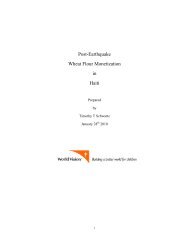Food Consumption Patterns Part 2
Create successful ePaper yourself
Turn your PDF publications into a flip-book with our unique Google optimized e-Paper software.
102<br />
there were vendors of both genders (the total exceeds 100% due to rounding). The most common<br />
snacks sold were cookies (46%), crackers (30%), and peanut butter (13%), while only 1%<br />
primarily sold popcorn. Thus, while there is only a weak formal distribution system in Haiti—as<br />
seen in the precious chapter-- the informal distribution system is so pervasive that 1/3 rd of all<br />
households are involved in redistribution. The reason for the extent of involvement in the snack<br />
trade has to do with the sheer numbers of people who are poor and dependent on petty trade. As<br />
seen at the outset of this report, 70% of the population hovers around the margin of extreme<br />
poverty. The vast majority conduct their daily routines—production, work, trade, and purchases—<br />
in the informal economy. But the formal economy impinges on their lives. It is the source of at<br />
least half of all food stuffs. And when it comes to trade and distribution there is an interchange<br />
between actors in the formal and informal market economies that offers a point of entry for saavy<br />
minded distributors, especially those with an eye on working with the poor.<br />
Plugging into the ‘Dueling Economies’<br />
The formal economy is the most important entry point for manufactured products but there is a<br />
relationship between the two that should not be overlooked and could provide a valuable tool to<br />
make the informal economy work to the advantage of marketers of RUTFs.<br />
In Seciton 6 it was seen that main actor in the formal economy is the komesan, the redistributor of<br />
mostly imported goods. By virtue of his/her link to the formal economy, the komesan has greater<br />
capital than the key actors in the informal economy, and often has access to a line of low-interest<br />
or even interest-free credit. The key actor in the informal economy is the sara, and because she is<br />
in the informal economy she can only access credit at exorbitant rates, as high as 23% per month.<br />
Even in the humanitarian aid-funded credit union sector she must pay 3% to 6% per month.<br />
Thus the komesan is able to exploit the sara by virtue of her desperation for credit. The komesan<br />
sell their imported staples, cookies, and crackers to the madan sara on credit. The woman has 21<br />
to 30 days to pay for the goods. If she sells it at retail market prices she stands to earn about 20%<br />
profit, over the period of one month. If she can sell it all. Because boutik and many other women<br />
also get the foods on credit and sell imported flour, rice, sugar, cookies and crackers out of their<br />
homes, the products sell slowly.<br />
So rather than wait and make a small profit, the madan sara dumps the imported foods at below<br />
market prices so that she can get the cash and trade in domestic produce, an endeavor in which she<br />
can earn more money, faster. The aggregate impact of what she has done is to subsidize agroindustrial<br />
imports from developed countries (imports that were already subsidized in the countries<br />
of origin). In other words, she is undermining her own local economy. And once again, the reason<br />
she does it is that she is desperate for market capital.<br />
The point here is while it seems an almost Machiavellian—but best understood as systemic and<br />
incidental--it should not go unnoticed that sellers of high nutrition RUTFs produced with local<br />
produce may find it justifiable—even prudent and in the best interest of both malnourished<br />
children and local producers—to exploit this arrangement by offering madan sara RUTFs on credit<br />
and letting them sell it as they see fit.
















